Have a safe day!
Wednesday, Aug. 21
3:30 p.m.
DIRECTOR'S COFFEE BREAK - 2nd Flr X-Over
THERE WILL BE NO FERMILAB COLLOQUIUM THIS WEEK
Thursday, Aug. 22
2:30 p.m.
Theoretical Physics Seminar - Curia II
Speaker: Roberto Vega-Morales, Northwestern University
Title: Golden Obsessions: Identifying the Higgs Through the Golden Channel
3:30 p.m.
DIRECTOR'S COFFEE BREAK - 2nd Flr X-Over
Click here for NALCAL,
a weekly calendar with links to additional information.
Ongoing and upcoming conferences at Fermilab
|
|
Wednesday, Aug. 21
- Breakfast: breakfast pizza
- Breakfast: ham, egg and cheese English muffin
- Carolina pulled-pork sandwich
- Smart cuisine: herb and lemon fish
- Baja chicken enchilada casserole
- Italian antipasto panini
- Pasta bar
- Vegetarian harvest moon vegetable soup
- Texas-style chili
Wilson Hall Cafe menu |
|
Wednesday, Aug. 21
Lunch
- Sundried tomato spiced shrimp
- Coconut-almond couscous
- Steamed broccoli
- Fresh lemon mousse
Friday, Aug. 23
Dinner
- Crab cocktail with parmesan chip
- Bristro bouillabaisse
- Baby spinach salad with warm citrus bacon vinaigrette
- Berry-filled cinnamon crepes
Chez Leon menu
Call x3524 to make your reservation.
|
|
Easy as 1, 2, 3-D printing
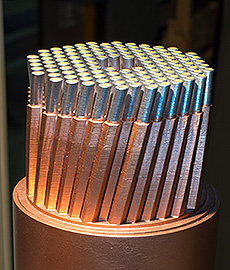 |
Sean Johnson, TD, used Fermilab's 3-D printer to make this model of a strand of Nb3Sn wire, which he then spray-painted. Photo: Steve Krave, TD
|
In 2008, Mauricio Lopes, an associate scientist in the Technical Division, started to build a model of a helical solenoid out of cardboard in order to prove a design concept. The process was painstakingly slow: In a week, he and Miao Yu, a mechanical engineer from TD, had finished only four rings. So Lopes thought of a solution for finishing such a model in a fraction of the time: a three-dimensional printer.
By October 2009, the Technical Division had its printer, a refrigerator-sized device housed in the Industrial Building Complex that spits out plastic renderings of computer models. The process takes anywhere from a few minutes to a few days, depending on the size and complexity of the object being printed.
"You can try things really fast," said Steve Krave, a mechanical engineer. "You can have something made over the weekend, and so you can try building something and see how it works in real life instead of spending hours and hours trying to analyze every little thing."
"And it's much less labor intensive," Lopes added.
Since Lopes first printed his helical solenoid model, the Technical Division has found a variety of uses for 3-D-printed pieces, including helping with winding coils for superconducting magnets. As coils are wound around a cylindrical surface, technicians need to control the shape of the magnetic field at the end of the coil in addition to alleviating stresses in the cable.
To do this, they use U-shaped end pieces, which traditionally have been ordered from machining vendors outside the lab, a process that can take about a month. With the 3-D printer, an end piece can be printed right in the lab, allowing for multiple iterations of the piece if changes need to be made.
"A lot of analysis and a lot of fabrication effort goes into making this curved surface," said Rodger Bossert, a mechanical engineer. "Being able to turn around these parts quickly and cheaply is a huge advantage."
Because forming the coils requires higher temperatures than Fermilab's 3-D printed parts can withstand, the printed shapes are used in trials. The final shapes are made of metal—sometimes from off-site 3-D printers. This allows TD to experiment with different designs. The printer, for example, can build notches into the U-shaped end pieces, allowing them to compress and expand.
It works much like a two-dimensional printer in concept: Instructions are created on a computer and sent to the printer, which then produces a physical replica of what you see on the computer screen. But instead of printing ink on paper, it prints melted plastic onto a flat surface, with a melted resin used as a support structure. Once the printing is complete, the water-soluble resin can be broken and washed off, leaving behind only the plastic, allowing for objects with multiple parts, like working gears, to be printed in their entireties instead of being assembled in individual pieces.
"With machining, you have to drill holes and cut things away," Krave said. "What's really cool about 3-D printing is that you can build all sorts of complicated structures at once."
—Laura Dattaro
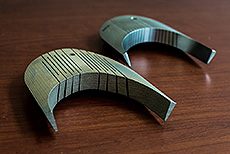 |
A modified end part that was 3-D printed off-site sits in the foreground, with a traditional, machined part in the background. Photo: Steve Krave, TD
|
|
Accelerator update, Aug. 18, 2013
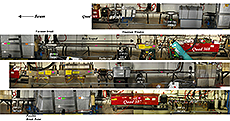 |
This sequence of photos shows the equipment and beam pipes located in sections 307 to 309 of the Main Injector. |
Proton Source, Linac and Booster
Commissioning and studies are in progress. Workers carried out maintenance in Linac and Booster on Aug. 13 and 14.
Main Injector/Recycler
Work continues to find the cause of the vacuum problems in the 307-309 sections of the Main Injector. The goal is to achieve a high vacuum of 10-8 torr. A contaminant inside the vacuum system has led to a higher-than-normal gas load. While this is acceptable for low-intensity beams, the vacuum needs to be improved for high-intensity beam operations. Accelerator Division sent out samples of bellows and other material inside the vacuum for testing for chemical composition.
Fixed-target area
Work on the Neutrino Muon beam line, which delivers beam to the SeaQuest experiment, progresses well. New beam pipes have been installed along approximately half the length of the beam enclosure. Welding of the third set of pipes is in progress.
View the AD Operations Department schedule.
|
Antimatter experiment seeks help from the crowd
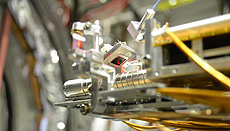 |
After a successful trial run, a CERN antimatter experiment plans to use crowdsourcing to analyze its data. Image: CERN
|
Scientists investigating the effect of gravity on antimatter recently conducted a different kind of experiment: They asked members of the public to help them analyze their data.
Anyone with access to a computer and the Internet was welcome to take part in the trial run, which went off without a hitch. The scientists plan to do it again in the coming months.
The AEgIS experiment at CERN (pictured above) examines beams of antimatter particles, recording the points at which they begin to deviate from their normal trajectories and the points at which they come into contact with matter and annihilate. Seeing how quickly—and in what direction—the particles fall will offer insight into just how the antimatter feels gravity's pull.
The experiment requires the scientists to match up pairs of dots to trace each particle's path. They have a lot of dots to connect.
"We have so much data that automation or many volunteers are the only options at this point," says CERN physicist Michael Doser, who leads the experiment.
Read more
—Ashley WennersHerron and Kathryn Jepsen
|
|
At Fermilab, National Accelerator is our middle name
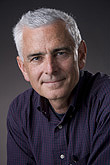 |
|
Craig Hogan
|
Craig Hogan, head of the Center for Particle Astrophysics, wrote this column.
Everyone knows that Fermilab builds accelerators, fabulous machines that boost elementary particles to almost the speed of light. But Fermilab accelerates more than just particles: It propels the advancement of our nation, and our technical civilization, into the future.
Fermilab's basic mission is to understand the nature of matter, energy, space and time. Since everything is made of matter moving in space-time, startling inventions often spring from innovations in physics. Surprising technologies emerge all the time from newly invented ways of measuring and manipulating matter, forces and data.
The sooner we get the knowledge, the sooner we get the inventions. The faster we learn new physics, the faster humanity advances. That's acceleration: It moves everything faster.
The most direct acceleration happens when physicists take their techniques out into the world and build all kinds of new things, not just physics experiments. Around the lab, we see this happening all the time in the careers of our close colleagues.
A couple of years ago I stood on a festively flower-festooned Stockholm stage, dressed in an elegant Swedish tuxedo, with an experimental team that celebrated the award of the Nobel prize in physics to two of our team members, Adam Riess and Brian Schmidt. The team had worked together in the 1990s to discover a unique kind of acceleration: the speeding up of the cosmic expansion, sometimes called "dark energy." Our two youngest team members had been physics graduate students at the time of the discovery; at our Nobel reunion feast 13 years later, they talked with excitement about their jobs at a Seattle biotech company, where they apply techniques they learned in experimental astrophysics to develop machines that study close details of living systems.
Last year, a brilliant postdoc from MIT who had helped us create Fermilab's Holometer experiment surprised everyone on that team when he chose not to become a physics professor at the University of Chicago but decided instead to join Elon Musk's SpaceX company and develop new ways of going to space. He's already developed a ranging system that the Dragon space capsule uses to dock with the International Space Station.
And just this summer, a senior Fermilab physicist, James Volk, left the lab and our Holometer team, not to retire, but to join a private biomedical company. He now develops magnets for accelerator beams—not for physics research, but for new kinds of cancer treatment.
These close-up stories show the substantial contributions that our colleagues make beyond basic physics research. They create things that did not exist before and make them happen better and sooner because of their physics training, experience and creative insight—just one of many ways that Fermilab accelerates our nation.
|
Chopper or zipper?
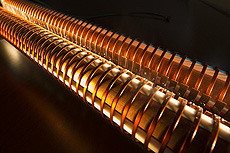 |
The answer is "chopper." This is one of two chopper schemes under development for the Project X Injector Experiment, or PXIE. Particle beams are made of series of particle packets called bunches. The chopper allows scientists to prescribe specific bunch patterns for a particle beam, dictating which bunches can remain in the beam and which have to go. As a particle beam travels down the length of the chopper, each of the rectangular plates lined up along the chopper's axis sets up an electrostatic pulse that kicks the bunch farther and farther away from the beamline, chopping it out.
Photo: Reidar Hahn |
|
ESH&Q weekly report, Aug. 20
This week's safety report, compiled by the Fermilab ESH&Q section, contains three incidents.
A contractor suffered first- and second-degree burns when his upper arm came into contact with a bare copper line. He received treatment and prescription medication, making this a recordable case. The copper line has been insulated and warning signs have been posted.
An employee’s hand was crushed between a 100-pound steel fixture and a dumpster. The employee is using a splint and will undergo occupational therapy. This case is under investigation but will likely be a DART case.
An employee noticed pain in his left knee on a July 16, 2013, flight to Chile.
Find the full report here. |
Argonne, Fermi national labs host fair to engage small contractors
From FCW, Aug. 20, 2013
Two of the most advanced U.S. research laboratories are about to throw open their doors to small businesses in hopes of sharing opportunities to supply goods and services and developing partnerships in technological development and commercialization.
On Aug. 21, the Department of Energy's Argonne and Fermi national laboratories are sponsoring their first business fair at Argonne's Theory and Computing Science Center in Downers Grove Township, Ill. The fair, said Argonne spokesman Alex Mitchell, will offer local small businesses and start-up companies a first-hand opportunity to learn about the labs' procurement group, technology development and commercialization group, user facility staff and small business support staff.
The labs said participants would interact with staff and attend sessions on subcontracting, procurement, technology transfer, sponsored research and how to engage scientific user communities.
Argonne said it spends more than $300 million per year through both large and small contractors.
Mitchell said the fair is aimed at boosting the labs' ambitious small business contracting goals and getting beyond the notion that the laboratories are off limits. "There's a perception that there is a wall around Argonne," said Alex Mitchell.
Read more |
|